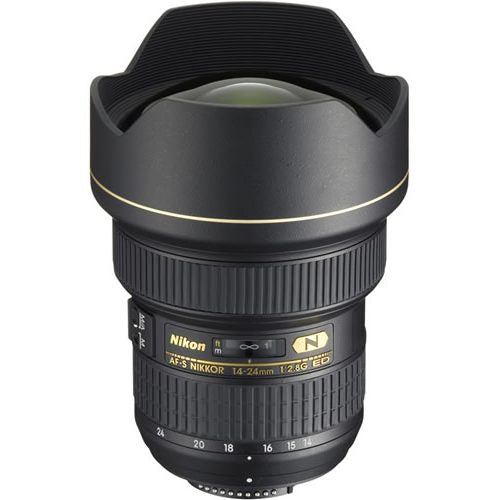Nikon
Nikon AF-S NIKKOR 14-24mm f/2.8 G ED Wide Angle Zoom Lens
Nikon AF-S NIKKOR 14-24mm f/2.8 G ED Wide Angle Zoom Lens
Couldn't load pickup availability
- Constant maximum aperture of f/2.8 at all focal lengths
- Enhanced optical formulas, engineered to produce exceptional sharpness, contrast and color, render outstanding image integrity
- ED (Extra-low dispersion) glass elements minimize chromatic aberration to deliver stunning sharpness and contrast
- Aspherical lenses including large-diameter PGM elements eliminate various types of lens aberration even at the widest aperture
- Nano Crystal Coat virtually eliminates internal lens element reflections, effectively reducing ghosting and flare
- High-performance Nikon Super Integrated Coating provides superior color reproduction, while minimizing ghosting and flare
- IF (Internal Focusing) enables focusing without changing the length of lens barrel
- Nikon??s exclusive Silent Wave Motor for fast, quiet autofocus operation
- Rounded diaphragm opening (9 blades) makes out-of-focus elements appear more natural
- 0.28 m/0.9 ft. closest focusing distance with focal length 18-24 mm
- M/A mode enables instant switching from autofocus to manual focus, even during AF servo operation, with virtually no time lag
- Dedicated flower-shaped lens hood effectively minimizes stray light
- Lens barrel is built for comfortable holding while featuring a rugged design; zoom and focusing rings provide smooth operation
- Engineered to Nikon professional D-SLR standards to effectively resist dust and moisture
ED
ED glass ??an essential element of NIKKOR telephoto lenses
Nikon developed ED (Extra-low Dispersion) glass to enable the production of lenses that offer superior sharpness and color correction by minimizing chromatic aberration.
Put simply, chromatic aberration is a type of image and color dispersion that occurs when light rays of varying wavelengths pass through optical glass. In the past, correcting this problem for telephoto lenses required special optical elements that offer anomalous dispersion characteristics ??specifically calcium fluoride crystals. However, fluorite easily cracks and is sensitive to temperature changes that can adversely affect focusing by altering the lens??refractive index.
So Nikon designers and engineers put their heads together and came up with ED glass, which offers all the benefits, yet none of the drawbacks of calcium fluorite-based glass. With this innovation, Nikon developed several types of ED glass suitable for various lenses.
They deliver stunning sharpness and contrast even at their largest apertures. In this way, NIKKOR?r ED-series lenses exemplify Nikon?r preeminence in lens innovation and performance.
SIC
Nikon Super Integrated Coating ensures exceptional performance
To enhance the performance of its optical lens elements, Nikon employs an exclusive multilayer lens coating that helps reduce ghost and flare to a negligible level.
Nikon Super Integrated Coating achieves a number of objectives, including minimized reflection in the wider wavelength range and superior color balance and reproduction. Nikon Super Integrated Coating is especially effective for lenses with a large number of elements, like our Zoom-NIKKOR lenses.
Also, Nikon's multilayer coating process is tailored to the design of each particular lens. The number of coatings applied to each lens element
is carefully calculated to match the lens type and glass used, and also to assure the uniform color balance that characterizes NIKKOR lenses. This results in lenses that meet much higher standards than the rest of the industry.
N
Nano Crystal Coat
Nano Crystal Coat is an antireflective coating that originated in the development of NSR-series (Nikon Step and Repeat) semiconductor manufacturing devices. It virtually eliminates internal lens element reflections across a wide range of wavelengths, and is particularly effective in reducing ghost and flare peculiar to ultra-wideangle lenses. Nano Crystal Coat employs multiple layers of Nikon?r outstanding extra-low refractive index coating, which features ultra-fine crystallized particles of nano size (one nanometer equals one millionth of a mm). Nikon now proudly marks a world first by applying this coating technology to a wide range of lenses for use in consumer optical products.
ASP
Aspherical lens elements
Nikon introduced the first photographic lens with aspherical lens elements in 1968. What sets them apart? Aspherical lenses virtually eliminate the problem of coma and other types of lens aberration ??even when used at the widest aperture. They are particularly useful in correcting the distortion in wideangle lenses. In addition, use of aspherical lenses contributes to a lighter and smaller lens design.
Nikon employs three types of aspherical lens elements. Precision-ground aspherical lens elements are the finest expression of lens-crafting art, demanding extremely rigorous production standards. Hybrid lenses are made of a special plastic molded onto optical glass. Molded glass aspherical lenses are manufactured by molding a unique type of optical glass using a special metal die technique.
IF
Internal Focusing (IF)
Imagine being able to focus a lens without it changing in size. Nikon??s IF technology enables jut
Share


